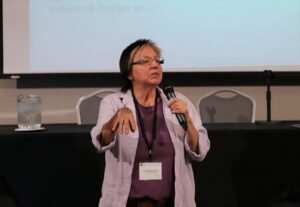Sheila Wahsquonaikezhik and the damage caused by human trafficking
Trigger warning: readers may be triggered by the recount of human trafficking and rape. To access a 24-hour Canadian Human Trafficking Hotline, call: 1-833-900-1010. Community Assistance Program (CAP) can be accessed for citizens of the Anishinabek Nation: 1-800-663-1142.

By Jesse Johnson
SAULT STE. MARIE, ON – Attendees were shocked and in tears while hearing stories about human trafficking and the horrors that come with it, but also don’t expect this lucrative multi-billion dollar industry to go anywhere anytime soon.
Sheila Wahsquonaikezhik, a member of Batchewana First Nation, holds a Masters in Environmental Studies from York University. Her expertise lies in Program Development for First Nations and organizations.
She spoke about human trafficking and how it is connected to the wider context of colonialism. She was trafficked between the ages of 14 and 17 internationally, specifically between Ontario and New York, NY, while in the care of the child welfare system.
Wahsquonaikezhik spoke about the pain, grief, and suffering that comes from colonization and human trafficking.
“When we look at the notion of colonization, the language itself lends itself to human trafficking and describes what has been done to us over the last centuries of this process of colonization – which we’re not over with yet,” she said. “The first step is incursion, which is the forced entry into a geographical area. If you think about that language, it really sounds like rape, doesn’t it? And that’s the first step of colonization. The destructive effects on social and cultural structures, political, economic, spiritual, and the disregard for values and norms is exactly what happens when you traffic.”
64% of all human trafficking in Canada takes place in Ontario. Worldwide, human trafficking is a multi-billion dollar industry. The offenders in these incidents were 81% male and the majority of victims are women (95%) and 70% were women under the age of 25. The average age of Indigenous girls forced into the sex trade is 11 or 12 (Sethi, 2007).
“Anything that exists can be made into pornography. Nowadays, you don’t have to worry about kids watching porn between humans. Now, they’re watching animated porn. This is disrupting the minds of children. I was trafficked at the most lucrative age. After that, the women are all worn and torn. They’re messed up. I was really messed up,” she explained. “I don’t want to take away from the fact that males are exploited as well. I want to acknowledge that fact… It’s not too early to talk to young people about trafficking. The time to talk is now. As they’re growing up, they need to be protected and informed. Growing up, knowledge is everything. It’s important to have that truth. Debwewin is a powerful tool.”
Waahsquonaikezhik then talked about the most famous human trafficking victim: Pocahontas.
“We’ve had 500 years and more of sanctioned trafficking of our children. Pocahontas was just a child. This foreign government has allowed this to happen for over 500 years.”
She then spoke about her time in Children’s Aid and how she was placed in a non-Indigenous home. She said the same violence and pornography that happened in her previous home continued to happen in her placement home because “they could hide it better”.
She recounted the experiments done by the United States and England in the 1950s where they took orphaned infants and deprived them of touch.
“They thought this would be a good experiment to do to infants. When 40 per cent of those children died, they realized this experiment wasn’t a good idea. Who in their right mind would think depriving any human of touch, let alone a baby, would be a good idea?” she stated. “There is something wrong with these people. They’re spiritually disenfranchised. There’s something wrong with humans if they think this is okay. They think trafficking children is okay. They think sexually abusing children is okay. It’s not okay.”
After getting in trouble with the law and having nowhere else to go, she notes that her next placement was with her trafficker.
“That was the worst place I could go. He trafficked me. I feared him until the day he died, which was only a few years ago.”
Through her keynote presentation, Sheila created greater awareness of the prevalence of human trafficking and the ongoing, lasting effects.
For more information about the 8th annual Anishinabek Nation Health Conference, visit: www.anishinabek.ca.


